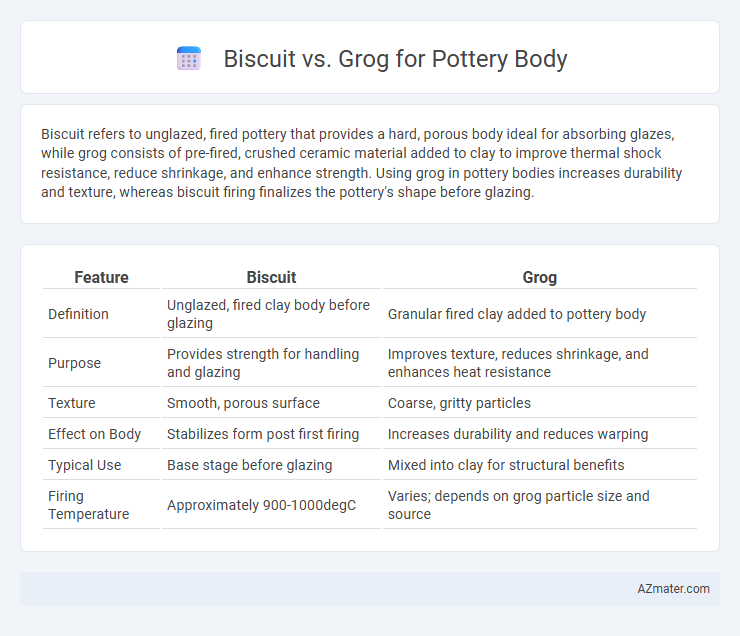Biscuit refers to unglazed, fired pottery that provides a hard, porous body ideal for absorbing glazes, while grog consists of pre-fired, crushed ceramic material added to clay to improve thermal shock resistance, reduce shrinkage, and enhance strength. Using grog in pottery bodies increases durability and texture, whereas biscuit firing finalizes the pottery's shape before glazing.
Table of Comparison
| Feature | Biscuit | Grog |
|---|---|---|
| Definition | Unglazed, fired clay body before glazing | Granular fired clay added to pottery body |
| Purpose | Provides strength for handling and glazing | Improves texture, reduces shrinkage, and enhances heat resistance |
| Texture | Smooth, porous surface | Coarse, gritty particles |
| Effect on Body | Stabilizes form post first firing | Increases durability and reduces warping |
| Typical Use | Base stage before glazing | Mixed into clay for structural benefits |
| Firing Temperature | Approximately 900-1000degC | Varies; depends on grog particle size and source |
Introduction to Pottery Body: Biscuit vs Grog
Pottery bodies often use biscuit and grog to enhance durability and workability, with biscuit referring to fired clay that has been hardened but not glazed, while grog consists of ground-up fired clay added as a temper to reduce shrinkage and improve texture. Biscuit-fired pottery allows for easier handling during glazing and decoration stages, whereas grog enhances the structural integrity and reduces cracking in the final piece. Understanding the differences between biscuit and grog is essential for selecting the appropriate material in pottery body formulation to achieve desired aesthetic and functional qualities.
Defining Biscuit and Grog in Pottery
Biscuit refers to unglazed, fired pottery that has undergone its first kiln firing, resulting in a hard but porous ceramic body ideal for further glazing or decoration. Grog consists of pre-fired clay particles or crushed fired pot fragments added to clay to improve its texture, reduce shrinkage, and increase structural strength during the shaping and firing processes. Incorporating grog enhances firing stability and workability, while biscuit represents the transitional ceramic state before final glazing and refiring.
Composition and Material Differences
Biscuit pottery is made from clay that has been fired once without glaze, resulting in a porous and matte surface ideal for detailed decoration and easy glazing. Grog, on the other hand, is a granular material composed of pre-fired and ground pottery fragments added to clay bodies to enhance texture, reduce shrinkage, and improve thermal shock resistance. While biscuit is a stage in the firing process, grog serves as an additive that modifies the clay's physical properties, making it crucial for sturdier and more durable pottery construction.
Impact on Workability and Plasticity
Biscuit clay offers reduced plasticity due to its partially fired state, making it less workable and more prone to cracking during manipulation, whereas grog-infused clay improves workability by introducing granular particles that enhance plasticity and reduce shrinkage. The presence of grog in pottery bodies facilitates better moisture retention and structural integrity, allowing for smoother shaping and greater resistance to deformation. Optimizing the balance of grog content significantly impacts the clay's plasticity, directly influencing the ease of hand-building and wheel-throwing techniques.
Influence on Fired Strength and Durability
Biscuit pottery body, being bisque-fired at lower temperatures, retains higher porosity, resulting in reduced fired strength and durability compared to grog-enhanced bodies. Grog, composed of ground fired clay or crushed ceramic, acts as a temper by improving thermal shock resistance, reducing shrinkage, and enhancing structural integrity in the fired pottery. The inclusion of grog significantly increases fired strength by creating a more robust matrix that withstands mechanical stress and prolonged use.
Texture and Surface Finish Comparison
Biscuit firing results in a porous, matte texture that enhances glaze adhesion, making it ideal for detailed surface decoration and further refinement. Grog, composed of pre-fired clay particles, adds roughness and structural strength to the pottery body, producing a gritty texture that reduces shrinkage and warping during firing. The surface finish with biscuit is smoother and more uniform, while grog imparts a coarse, tactile quality suited for functional, durable ceramics.
Effects on Shrinkage and Warping
Biscuit firing significantly reduces moisture content and organic materials in the pottery body, minimizing shrinkage during the final glaze firing compared to grog, which contains pre-fired clay particles that improve dimensional stability and reduce warping. Grog particles act as a physical filler, providing strength and reducing thermal contraction, thereby controlling shrinkage and preventing deformation during drying and firing cycles. Combining biscuit firing with grog-enhanced clay bodies optimizes shrinkage control and warping resistance for durable, stable ceramic pieces.
Suitability for Functional vs Decorative Ware
Biscuit-fired pottery, with its porous and matte surface, is ideal for decorative ware that requires a refined finish for glazing and painting. Grog-enhanced clay bodies improve thermal shock resistance and structural strength, making them suitable for functional ware like cookware and storage vessels. The inclusion of grog prevents warping and cracking during firing, ensuring durability in everyday use.
Cost and Availability Considerations
Biscuit firing offers lower initial material costs due to its widespread availability of raw clay and simpler processing, making it budget-friendly for pottery body preparation. Grog incorporation increases expenses because of the additional manufacturing step and specialized sourcing required for pre-fired ceramic granules, but it enhances clay durability and firing performance. Availability of grog varies by region, potentially affecting overall cost and lead times compared to the universally accessible biscuit clay.
Conclusion: Choosing Between Biscuit and Grog
Choosing between biscuit and grog for pottery body depends on the desired texture and firing properties; biscuit offers smoothness but is prone to shrinkage, while grog enhances durability and reduces cracking by adding granularity. Potters aiming for strength and reduced warping often prefer grog, especially in functional ceramics requiring thermal shock resistance. Selecting the right additive balances workability and structural integrity, optimizing the clay body for specific artistic or utilitarian goals.

Infographic: Biscuit vs Grog for Pottery Body
 azmater.com
azmater.com